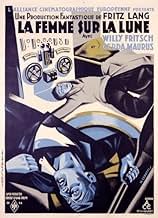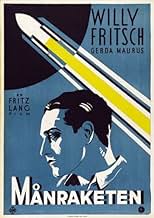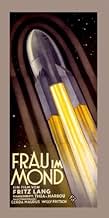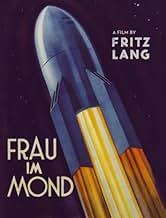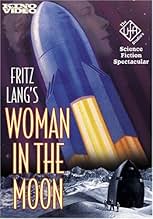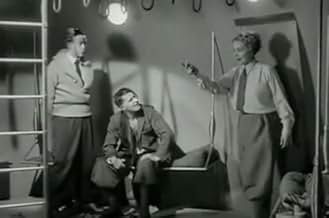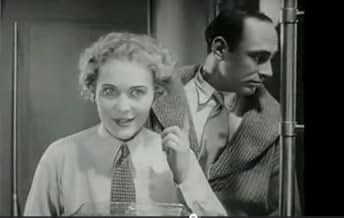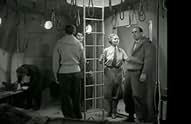AVALIAÇÃO DA IMDb
7,3/10
4,1 mil
SUA AVALIAÇÃO
Um cientista tenaz parte em direção à Lua na esperança de encontrar riquezas que possam ser encontradas lá.Um cientista tenaz parte em direção à Lua na esperança de encontrar riquezas que possam ser encontradas lá.Um cientista tenaz parte em direção à Lua na esperança de encontrar riquezas que possam ser encontradas lá.
- Prêmios
- 1 indicação no total
Gustl Gstettenbaur
- Gustav
- (as Gustl Stark-Gstettenbaur)
Gustav von Wangenheim
- Hans Windegger - Engineer
- (as Gustav v. Wangenheim)
Alexa von Porembsky
- Eine Veilchenverkäuferin
- (as Alexa v. Porembska)
Heinrich Gotho
- Der Mieter vom II. Stock
- (as Gotho)
Alfred Loretto
- Zwei eindeutige Existenzen
- (as Loretto)
Max Maximilian
- Grotjan, Chauffeur bei Helius
- (as Maximilian)
Edgar Pauly
- Zwei eindeutige Existenzen
- (as Pauly)
Karl Platen
- Der Mann am Mikrophon
- (as Platen)
Mahmud Terja Bey
- Fünf Gehirne und Scheckbücher
- (as Terja Bey)
Hermann Vallentin
- Fünf Gehirne und Scheckbücher
- (as Vallentin)
Avaliações em destaque
Let's face it 'Woman in the Moon' is hardly one of the great Fritz Lang's best efforts: far, far too long, badly paced, ludicrously over-melodramatic and just plain silly. Nevertheless, it contains prescient details in regards to space travel and (as should be expected) looks absolutely fabulous. Lang even made claims that this was the first film to feature a rocket launch countdown and who are we to question him? One thing you can be certain of is that going to the moon would never again look so stylish. Even though this is the tail end of Lang's classic silent period, those who love films like 'Dr. Mabuse' and 'Spies' will still find much to enjoy here.
This was Fritz Lang's last silent film. It is a science fiction adventure in which a scientist, Professor Georg Manfeldt, had theorized that there were large supplies of gold on the moon. He was ridiculed by his peers and disgraced because of this. However, a wealthy industrialist believes Manfeldt's theory and has been building a rocket to travel to the moon. when a group of wealthy men who control the world's gold supply feel threatened by the possibility the theory may be correct, they threaten to destroy the rocket unless one of their agents, Turner, is allowed to go on the expedition too. Apparently Lang's film got so much right about space travel that the Germans seized the models used in the film as state secrets when they started their own rocket-building program. This film runs 169 minutes and is quite slow in places. It has some very interesting and thrilling scenes, but it is probably one of the weaker of Lang's films that I have seen.
"Frau im mond" is undoubtedly one of the first and most important Sci-Fi movies ever made. Directed by Austrian director Fritz Lang best known for his masterpieces "M" and "Metropolis", it's a story of a half-mad greedy scientist obsessed with the idea of getting gold from the moon and a moon expedition that follows, there is also a love story that goes along. The look of the film is quite impressive, considered that it was made in 1929. Hitler later banned it, because the spaceship featured there was nearly identical to V-2s that were constructed in secrecy by the Third Reich at the time. An early Sci-Fi classic, a must see for any serious Sci-Fi fan. 8/10
Frau im Mond may appear scientifically outlandish to the modern viewer, and the high-style expressionistic acting of its actors overdone, but nevertheless the film should be recognized as a landmark which impacted world history. The UFA studio commissioned a then small and marginal band of German amateur rocket aficionados centered around Hermann Oberth to work as technical consultants to the film's designers, and UFA even commissioned them to build a rocket to be fired at the film's premier in Berlin. The rocket wasn't completed in time, but the laboratory furnished by UFA, not to mention the heady excitement of a brush with the highest level of cinema, and the salutory infusion of unexpected cash, together set some of these young rocketeers on their life paths. These included Willy Ley, and a young Prussian aristocrat engineer named Wehrner von Braun.
When the Nazis came to power, Fritz Lang parted with his wife and partner Thea von Harbou and came to Hollywood. The production models of the liquid-fired rockets from Frau im Mond were so advanced that in 1936 the Gestapo seized them as state secrets. Werhner von Braun went on to develop the brilliant Nazi terror weapon known as the V-2. Post-war, the V-2 and its German designers begat both the American and Soviet space programs. All subsequent space history was profoundly influenced by these developments. Frau im Mond maintains its impact to the present day. For just one example-- purely as a dramatic device to build tension before the rocket's lift-off to the Moon, Fritz Lang introduced title cards counting down from ten to one. The "countdown",as it became known, was so successful that NASA and everybody else has been doing it ever since.
When the Nazis came to power, Fritz Lang parted with his wife and partner Thea von Harbou and came to Hollywood. The production models of the liquid-fired rockets from Frau im Mond were so advanced that in 1936 the Gestapo seized them as state secrets. Werhner von Braun went on to develop the brilliant Nazi terror weapon known as the V-2. Post-war, the V-2 and its German designers begat both the American and Soviet space programs. All subsequent space history was profoundly influenced by these developments. Frau im Mond maintains its impact to the present day. For just one example-- purely as a dramatic device to build tension before the rocket's lift-off to the Moon, Fritz Lang introduced title cards counting down from ten to one. The "countdown",as it became known, was so successful that NASA and everybody else has been doing it ever since.
One of the coolest things for any silent film buff is to discover a film that they hadn't heard of or known too much about. That's the case with Fritz Lang's restored "Woman in the Moon", in the 2004 KINO DVD release, in which the print quality is excellent and a new piano/synthesizer score has been added. As has been cited by many others here, the pacing of much of the picture is slow and the acting is occasionally melodramatic, but as was occurring with most movies in the latter days of the silents, the acting techniques were moving form the broad stage performances of early film to more controlled and realistic portrayals and most of the actors were of the latter group. In addition to the surprisingly realistic portrayal of many aspects of what would become space flight, it is interesting that the space (science fiction) aspect is not the focus of the movie. The movie deals primarily with six characters and the tensions caused by greed, love, scientific curiosity and boyish hero worship. The fact that they are making a trip to the moon to verify a theory that gold might be mined there is just the vehicle of the story. And the story itself is pretty decent, especially if you have the patience to let the movie tell it. And even though I am a fairly jaded film buff, I found myself genuinely startled and surprised at least twice by plot turns.
I love it when that happens.
Be patient. Its 169 minutes, but I think it is worth it.
I love it when that happens.
Be patient. Its 169 minutes, but I think it is worth it.
Você sabia?
- CuriosidadesThis film shows the first countdown to the launch of a rocket - not just the first one in a movie, but the first ever. It was invented as a dramatic device for the movie. Previously, all launches were begun with a count upward from zero to a designated number (usually ten). Also depicted for the first time are the use of liquid rocket fuel, a rocket with two stages, and zero gravity in space.
- Erros de gravaçãoWhen Helius listens for Friede's heartbeat, fearing that the launch may have killed her, we can see her breathing heavily.
- Citações
[Opening intertitle]
The Author: "Never" does not exist for the human mind... only "Not yet."
- Cenas durante ou pós-créditosFritz Rasp is billed in the opening credits as "Der Mann, der sich Walter Turner nennt" or "The man who calls himself Walter Turner."
- Versões alternativasThe film was given a release from Kino Internation on DVD, running a length of 169 minutes. The 2000 restoration runs 200 minutes. The original showing in the United States ran 156 minutes and was later cut to 95 minutes.
- ConexõesEdited into Histoire(s) du cinéma: Le contrôle de l'univers (1999)
- Trilhas sonorasHeimlich singt für uns die Liebe
Music by Willy Schmidt-Gentner
Lyrics by Fritz Rotter
Sung by Gerda Maurus and Willy Fritsch
Principais escolhas
Faça login para avaliar e ver a lista de recomendações personalizadas
- How long is Woman in the Moon?Fornecido pela Alexa
Detalhes
- Data de lançamento
- País de origem
- Idioma
- Também conhecido como
- Woman in the Moon
- Locações de filme
- Empresas de produção
- Consulte mais créditos da empresa na IMDbPro
- Tempo de duração
- 2 h 36 min(156 min)
- Mixagem de som
- Proporção
- 1.33 : 1
Contribua para esta página
Sugerir uma alteração ou adicionar conteúdo ausente

